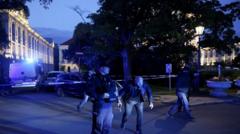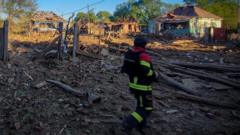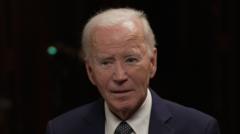**An analysis of the recent U.S. warnings to Russia reveals the growing complexities of the Russia-Ukraine conflict and its implications for global security.**
**Escalating Tensions: U.S. Warns Russia Over Potential Air-Cargo Sabotage Plot**

**Escalating Tensions: U.S. Warns Russia Over Potential Air-Cargo Sabotage Plot**
**White House officials urgently sought to communicate with Putin after intelligence on Russian plans surfaced.**
In a troubling turn of events, the Biden administration has ramped up efforts to dissuade Russian President Vladimir V. Putin from a potentially catastrophic plan linked to air cargo operations. Following a series of incidents where seemingly innocuous cargo shipments mysteriously caught fire across various European airports, U.S. intelligence indicated that Russia might be contemplating a broader strategy that could jeopardize American and Canadian air traffic safety.
In August of this year, U.S. officials became particularly concerned after surveillance data pointed to Russian military intelligence (G.R.U.) discussions about a series of tests involving consumer products, including a small electronic device intended to ignite upon delivery. Observers in Washington and across Europe noted that these incidents hinted at a more sinister intention: to escalate the Ukraine conflict beyond its borders and threaten citizens in North America.
The burning packages, initially seen as simple accidents, now raise the alarm about possible future assaults. Notably, there was a fears that if Russia refined its methods, these devices could be transported via cargo planes or even integrated into passenger flights. This situation required a strategic response to convey the potential risks directly to Putin and avert a larger crisis.
White House officials convened a series of high-level discussions to formulate precise communication lines for warning Moscow. The focus was on ensuring that Russia understood the severe implications of continuing such operations, both for U.S.-Russia relations and international stability at large. The gravity of the situation reflects the intricate balance of power currently at play in the geopolitical landscape, as tensions rise amidst a protracted conflict in Eastern Europe.
As the United States navigates these complexities, the comprehensive security landscape underscores the need for awareness and vigilance, testing diplomatic efforts designed to preserve air safety and foster peaceful engagement rather than conflict escalation.
In August of this year, U.S. officials became particularly concerned after surveillance data pointed to Russian military intelligence (G.R.U.) discussions about a series of tests involving consumer products, including a small electronic device intended to ignite upon delivery. Observers in Washington and across Europe noted that these incidents hinted at a more sinister intention: to escalate the Ukraine conflict beyond its borders and threaten citizens in North America.
The burning packages, initially seen as simple accidents, now raise the alarm about possible future assaults. Notably, there was a fears that if Russia refined its methods, these devices could be transported via cargo planes or even integrated into passenger flights. This situation required a strategic response to convey the potential risks directly to Putin and avert a larger crisis.
White House officials convened a series of high-level discussions to formulate precise communication lines for warning Moscow. The focus was on ensuring that Russia understood the severe implications of continuing such operations, both for U.S.-Russia relations and international stability at large. The gravity of the situation reflects the intricate balance of power currently at play in the geopolitical landscape, as tensions rise amidst a protracted conflict in Eastern Europe.
As the United States navigates these complexities, the comprehensive security landscape underscores the need for awareness and vigilance, testing diplomatic efforts designed to preserve air safety and foster peaceful engagement rather than conflict escalation.




















